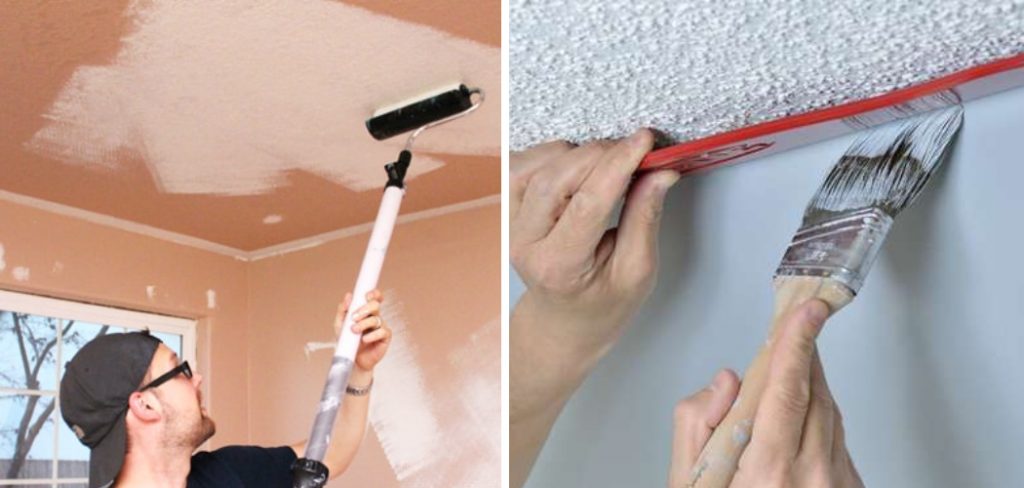Painting a ceiling can be a messy and tedious task, but it is necessary to maintain the overall appearance of your home. A fresh coat of paint on the ceiling can brighten up the room and make it look clean and new. However, painting a ceiling without making a mess requires some preparation and proper techniques.

The main advantage of learning to paint ceiling without making a mess is that you can save time, money and effort. By avoiding a messy painting process, you won’t have to spend extra time cleaning up or buying more paint to fix mistakes. In this blog post, You will learn in detail how to paint ceiling without making a mess.
Step-by-step Instructions for How to Paint Ceiling Without Making a Mess
Step 1: Inspect the Ceiling
Take a close look at your ceiling and check for any cracks or holes. If you find any, make sure to patch them up before starting to paint. Cover the entire floor with drop cloths or plastic sheets to protect it from paint spills. Move all furniture out of the room or cover them with plastic sheets.
Step 2: Prepare the Paint
Choose a high-quality ceiling paint and mix it well before use. Pour some into a roller tray for easy application. Use a small angled brush to cut in along the edges of the ceiling, such as around light fixtures or corners. This will make it easier to cover the rest of the ceiling with a roller.
Step 3: Use a Roller for Larger Areas

Attach an extension pole to your roller and start painting the ceiling. Work in small sections, starting from one corner of the room and moving towards the opposite side. If you are painting over a darker color or want to achieve a smoother finish, apply multiple coats of paint. Make sure to let each coat dry completely before applying the next one.
Step 4: Use a paintbrush for tight spaces
For areas that are difficult to reach with a roller, use a small paintbrush to carefully cover them with paint. Open windows or use fans to keep the room well-ventilated while painting. This will help the paint dry faster and reduce any strong odors.
Step 5: Clean up properly
Make sure to clean your brushes, rollers, and other tools properly after use. If you plan on taking a break from painting, wrap your tools in plastic to keep them from drying out. Once you have finished painting, let the ceiling dry completely before removing drop cloths and moving furniture back into the room. This may take a few hours or even overnight, so plan accordingly.
By following these simple steps, you can paint your ceiling without making a mess. Remember to always take your time and be thorough in your painting process for the best results.
Safety Precautions for How to Paint Ceiling Without Making a Mess

- Use drop cloths or plastic sheets to cover the floor and furniture in the room. This will protect them from any accidental spills or drips of paint.
- Wear old clothing or a painting apron to avoid getting paint on your clothes. It’s also a good idea to wear gloves to protect your hands.
- Open windows and use fans for proper ventilation while painting. This will prevent you from inhaling too many fumes or getting dizzy from the paint smell.
- Use a sturdy ladder and have a spotter hold it steady while you are climbing up and down. This will prevent any accidents or falls while painting.
- Use painter’s tape to cover edges, corners, and trim that you don’t want to get painted. This will ensure clean and straight lines without any mess.
- Start painting from the middle of the ceiling and work your way out to the edges. This will help prevent paint from dripping onto your face or arms.
- Take breaks every now and then to stretch, hydrate, and rest your arms and hands.
By following these safety precautions, you can successfully paint your ceiling without making a mess or risking any accidents. However, there are a few additional things to keep in mind for a smooth and successful painting process.
Importance of a Cleaning and Well-painted Ceiling
- A clean and well-painted ceiling can improve the overall aesthetics of any room. It adds a touch of freshness and brightness to the space, making it feel more inviting and visually appealing.
- A dirty or stained ceiling can be very unattractive and give off a neglected or unkempt appearance. This can greatly affect the first impression of visitors or potential buyers if you are trying to sell your home.
- Regular cleaning and repainting of the ceiling can also help with maintaining good indoor air quality. Over time, dust, dirt, and other pollutants can accumulate on the ceiling and impact the air you breathe. By regularly cleaning and painting the ceiling, you are removing these harmful particles and creating a healthier living environment for yourself and your family.
- In addition to improving the appearance and air quality of a room, a clean and well-painted ceiling can also help with natural lighting. A dirty or dark-colored ceiling can absorb light, making the room appear darker and smaller. By having a white or lightly colored ceiling, you are reflecting more light back into the space, creating an illusion of more space and brightness.
- Cleaning and painting the ceiling can also help with detecting any potential issues or damages. By regularly inspecting and cleaning your ceiling, you may be able to identify any cracks, water damage, or mold growth early on. This can prevent these issues from spreading and becoming costly repairs in the future.
- A clean and well-maintained ceiling can also increase the lifespan of your home’s structure. Moisture and dirt can lead to deterioration of the ceiling materials, which can weaken its structural integrity. By regularly cleaning and repainting, you are protecting the ceiling from these damaging factors, ensuring it remains strong and sturdy for years to come.

By now, you should understand the importance of keeping your ceiling clean and well-painted. Not only does it improve the overall appearance of your home, but it also helps with air quality, lighting, and maintenance.
Common Challenges in Ceiling Painting and Potential Mess Factors
There is no denying that painting the ceiling can be a daunting task. Not only does it require a great deal of effort and attention to detail, but it also poses various challenges and potential mess factors that need to be taken into consideration. In this section, we will discuss six common challenges in ceiling painting and how to address them.
1. Height
One of the most obvious challenges of ceiling painting is the height factor. Unless you have a very tall ladder or scaffolding, reaching the ceiling can be difficult and even dangerous. This challenge becomes even more apparent when painting ceilings in multi-story homes or buildings.
To address this challenge, it is important to prioritize safety first. Make sure you have a sturdy ladder or scaffolding that is properly secured and can support your weight. If the ceiling is too high, consider hiring a professional painter who has the necessary equipment and expertise to handle the task safely.
2. Drips and Splatters

Painting a ceiling requires a lot of skill, patience, and precision. One wrong move of the roller or brush can result in drips and splatters that can ruin your walls, furniture, and floors. This can be a major headache to clean up and can also lead to additional expenses.
To avoid this challenge, always use drop cloths or plastic sheets to protect your surroundings. Invest in high-quality paintbrushes and rollers that will help you achieve smooth and even strokes. It is also helpful to have a wet rag nearby to immediately wipe off any drips or splatters.
3. Uneven Coverage
Another challenge in ceiling painting is achieving uniform and even coverage. This can be tricky, especially when dealing with textured ceilings that have a lot of nooks and crannies. Uneven coverage can ruin the overall appearance of the room and may require additional coats of paint to fix.
To combat uneven coverage, use a primer before painting to create a smooth surface for the paint to adhere to. Take your time and use long, even strokes when applying the paint. It may also be helpful to have a friend or family member assist you in painting to ensure even coverage.
4. Lighting
Lighting can play a significant role in how the final color of your ceiling appears. Natural light, artificial light, and different light intensities can all affect the color and make it appear different than what you had in mind. This challenge is particularly important to consider if you are painting a ceiling that is visible from multiple angles or rooms.
To address this challenge, test out your paint color in different lighting situations before committing to painting the entire ceiling. This will give you a better idea of how the color will look in different light and make any necessary adjustments.
5. Neck and Back Strain

Painting a ceiling requires you to constantly look up, which can put a strain on your neck and back. This is especially true if you are not used to this type of physical activity or have preexisting neck or back conditions.
To avoid straining your neck and back, take frequent breaks and stretch your muscles. Consider using a roller extension pole to avoid constantly looking up or invest in a comfortable neck brace.
6. Choosing the Right Paint
Last but not least, choosing the right paint for your ceiling can be a challenge in itself. With so many options available on the market, it can be overwhelming to determine which one is best suited for your project. Factors such as sheen, durability, and coverage need to be taken into consideration.
To tackle this challenge, do your research and consult with a professional at a paint store. They can provide you with expert advice on which type of paint would work best for your specific ceiling and budget.
Benefits of a Mess-free Ceiling Painting Experience
Having a mess-free ceiling painting experience can bring numerous benefits, both short-term and long-term. In this section, we will discuss the various advantages that you can enjoy by following the methods and tips outlined in this guide.
1. Saves Time and Effort
One of the most significant benefits of achieving a mess-free ceiling painting experience is the time and effort you save. By using proper techniques and tools, you can avoid splattering paint on your walls, floors, and furniture.
This means less time spent cleaning up after the painting job is done. Additionally, with a mess-free approach, you will not have to worry about covering or moving furniture before starting the project, saving you even more time and effort.
2. Prevents Damage and Stains
Paint spills and splatters can cause severe damage to your walls, floors, and furniture. It can also leave permanent stains that are difficult to remove. By achieving a mess-free ceiling painting experience, you can prevent such damages and maintain the pristine condition of your home.

3. Better Quality Results
A mess-free painting experience allows you to focus on the task at hand without worrying about creating a mess. This means you can put more effort into achieving smooth and even paint coverage, resulting in a better quality finish. With fewer distractions, you can also pay attention to detail and achieve a professional-looking result.
4. Cost-effective
By avoiding paint spills and splatters, you can save money on cleaning supplies and potential repairs or replacements needed for damaged items. Additionally, with better quality results, you may not need to repaint your ceiling as frequently, saving you money on paint and other materials.
5. Improved Safety
Paint spills can create hazardous conditions by making surfaces slippery. With a mess-free painting experience, you can minimize the risk of accidents and injuries caused by slippery floors. It also reduces the chances of accidentally inhaling or ingesting paint, which can be harmful to your health.
6. Environmentally Friendly
Achieving a mess-free ceiling painting experience also has environmental benefits. By using less paint and producing less waste, you are reducing your carbon footprint and helping to protect the environment. Additionally, by properly disposing of paint and other materials, you can prevent harm to the environment and wildlife.
A mess-free ceiling painting experience not only makes your painting project more efficient and hassle-free but also brings various benefits. From saving time and effort to protecting your home, achieving a mess-free approach is a win-win situation for both you and the environment.
Troubleshooting Common Issues
One of the biggest challenges when painting a ceiling is avoiding making a mess. No matter how careful you are, there will most likely be some drips and splatters that end up on the floor or furniture. However, by following these solutions and tips for troubleshooting common issues, you can minimize the mess and make your painting process much smoother.

Issue 1: Uneven Paint Coverage
If you notice that your ceiling has uneven paint coverage after the first coat, don’t panic. This is a common problem and can easily be fixed by applying a second coat of paint. Make sure to use long, even strokes and overlap each stroke slightly to blend in the edges.
Issue 2: Drips and Splatters
To avoid drips and splatters, make sure to use a high-quality paint roller with a smooth, even surface. Also, be mindful of how much paint you load onto the roller. Too much paint can cause drips and splatters. Additionally, always have a damp cloth on hand to quickly wipe away any drips or spills.
Issue 3: Paint Bleeding Through Tape
To prevent this issue, make sure to securely press down the edges of the painter’s tape before painting. You can also use a putty knife to further seal the edges. If paint still bleeds through, wait for the first coat of paint to dry completely and then carefully touch up any areas with a small brush.
Issue 4: Peeling Tape
If the painter’s tape starts to peel off while you are painting, it could be because the paint is drying too quickly. To fix this, lightly mist the edges of the tape with water before painting over them. This will slow down the drying process and allow for cleaner lines.
By following these tips and troubleshooting common issues, you can successfully paint your ceiling without making a mess.
Conclusion
In conclusion, painting a ceiling can be a messy and challenging task, but with the right techniques and preparations, it can be made much easier. However, even with these methods, there are still some potential disadvantages to consider when attempting to paint a ceiling without making a mess.
One of the main drawbacks is the amount of time and effort it may take. Painting a ceiling requires some physical labor, and if there are any obstacles such as furniture or light fixtures in the way, it may take even longer to complete.
Another disadvantage is the possibility of uneven coverage or missed spots. Painting a ceiling can be a tricky task, especially when working on a higher surface. This can result in uneven coverage or missed spots, which would require touch-ups and additional time spent on the project. I hope reading this post has helped you learn how to paint ceiling without making a mess. Make sure the safety precautions are carried out in the order listed.
